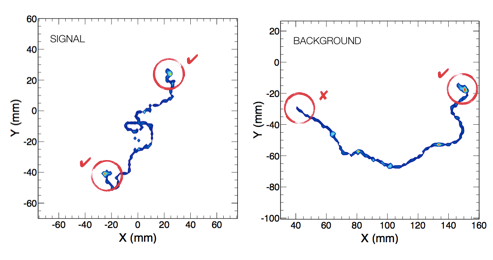Tracking the true nature of neutrinos
![]()
The NEXT design optimizes energy resolution by using proportional electroluminescent amplification, which provides a large yield of photons as a signal.  The electroluminiscent light is read with very high resolution by a plane of photomultipliers on one end of the chamber. On the other hand, the time projection chamber allows the measurement of the topological signature of the event to further reduce the background contamination: the two electrons of the decay leave a track with almost constant energy deposition and two big “blobs” of energy at the ends, due to the fact that electrons deposit their energy faster when their velocity is lower, at the end of their track. On the contrary, background is essentially constituted by single electrons which present only one “blob” at one end, allowing to neatly reject such events. In NEXT, a plane of silicon photomultipliers on the second end of the chamber, arranged as a regular matrix, is responsible for the tracking, measuring the 3D geometry of the tracks left by charged particles within the gas.
The electroluminiscent light is read with very high resolution by a plane of photomultipliers on one end of the chamber. On the other hand, the time projection chamber allows the measurement of the topological signature of the event to further reduce the background contamination: the two electrons of the decay leave a track with almost constant energy deposition and two big “blobs” of energy at the ends, due to the fact that electrons deposit their energy faster when their velocity is lower, at the end of their track. On the contrary, background is essentially constituted by single electrons which present only one “blob” at one end, allowing to neatly reject such events. In NEXT, a plane of silicon photomultipliers on the second end of the chamber, arranged as a regular matrix, is responsible for the tracking, measuring the 3D geometry of the tracks left by charged particles within the gas.
A first stage of the NEXT detector, named NEXT-WHITE (NEW), after the name of our late collaborator James White, is currently being installed in the Canfranc Underground Laboratory. Between October and November an active campaign has been carried out, resulting in the installation of the energy and the tracking planes, with their more than 1,800 sensors connected and working. The gas system is ready too, and the whole shielding system has been built, which protects the detector from external natural radiation originating in the walls of the laboratory. In the coming months NEW will begin to take data with its main aim being to characterize with a great precision the expected background of the detector. It will allow also to measure the two-neutrino double beta decay, but it is not expected to be sensitive to the neutrinoless mode because NEW will contain just 10 kg of xenon, as compared to the 100 kg nominal load of NEXT. NEW will pave the ground for the following phase of the experiment, NEXT-100, which will indeed be able to probe the possibility of whether neutrinos are their own antiparticles.
















